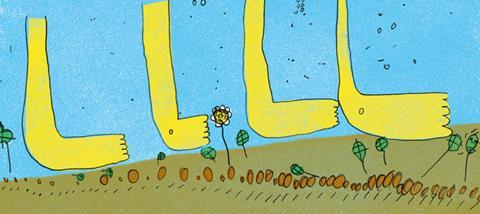
Ten per cent of UK children between the ages of 5 and 16 have a diagnosable mental health problem. There are many theories around why so many children and young people are suffering with poor mental health. One is that our children’s lives are increasingly busy, noisy and rushed.?
I work part time as a nurture consultant, supporting 4-year-olds with social, emotional and mental health needs during their reception year. Alongside this I research and write about children’s well-being and deliver training. Over my 30 years of working with children and young people I have noticed how increasingly stressed and anxious they are becoming. I believe as Christians, and as a Church, we need to address this. Through our churches, communities and education settings we work with many children, so we are in an excellent position to offer tools that can help them when they are feeling anxious, stressed and worried.
One area I believe the Church can explore further is contemplative and stillness practice. Within the secular world this is often called mindfulness. Mindfulness is recognised as being beneficial in helping adults and children improve their well-being and mental health. Yet this word leaves many Christians feeling uncomfortable; fearful that this is an Eastern religious practice, and therefore one we should avoid. However, scholars such as Richard Rohr, Ian Adams, Martin Laird, Thomas Merton and Benignus O’Rourke remind us that contemplative, stillness practice is a long-held tradition within Christianity, stretching back to the time of our desert mothers and fathers.?
Pursuing silence
Our lives are noisy. Just for a moment, think through your day. When did you last encounter silence? Often our prayer lives are full of words. So much of our work with children, both in church and in education, is busy, loud and rushed. So often our worship times at church are loud, noisy and wordy. At home we often have the radio or TV on. In the UK, many of us have lost the ability to sit comfortably in silence.
There is a growing recognition that the Church needs to re-engage with these old practices among adults. However, there are very few voices encouraging the same practices among children. Mark Yaconelli has written an excellent book on exploring this practice with young people, and for the last 21 years I have been exploring how we can use silence and contemplative practice with children as families in the home, at church and within early years and education. I firmly believe we need to relearn how to enjoy silence and how to hear God in the stillness, and then teach these skills to children. Below are a few ideas on how we can do this with children over 3.?
Being outside
How often do you use outside spaces in your worship or children’s time? Personally, I feel closest to God when I’m outside. The church I go to is a forest church, so all my time in a church setting is spent in woodland. I am not suggesting everyone needs to (or is able to) move outside to do church, but I have found that being outside in nature provides a draw and encouragement to be quiet, listen and notice.
One exercise I have used over the years is a sensory or listening walk, which is a good way to help children really listen, become aware of what is around them and engage with God’s wonderful creation. This is a good introductory activity to help them be mindful and still their minds. It can also help to calm an anxious or overactive child.
Find a space to walk around a garden, in some woods or along a road. Tell the child or group that you are going to be listening very carefully to all the different sounds. For this to work you will all need to be silent, if possible. Explain that this is a prayerful walk. As they walk, their attention may be taken by something they want to pray or give thanks for. The walk in itself is a prayer, as they are walking with God.?
At the end, ask them what sounds they heard. You could ask what the sounds helped them think of and made them feel. You may also want to ask what God has said to them through these sounds. Sometimes I get people to do this exercise with bare feet, where it is safe to do so. It forces us to slow down, so we become more aware of what is around us, how we feel and what we see.
I recently ran a well-being workshop for year 4 and 5 pupils at Wells Cathedral. During the day I worked with 90 children in groups of 30. One of the first activities was a silent barefoot walk around the cathedral garden, noticing, listening and engaging their senses for around ten minutes. At the end I asked how they felt and they said: “Calm”, “Peaceful”, “Happy” and “I felt God was here”. The staff were surprised at how calm and relaxed the children were. To see so many experience such a strong sense of calmness and God’s presence was incredibly moving.
Bubble prayers?
These have become a firm favourite of mine. I regularly use bubbles as a nurture consultant, as they have a very calming effect on children. Over the last 20 years I have been involved in different ways of exploring church and bubble prayers have always been part of our services. We have also used them at weddings, funerals and christenings.?
If possible, hand out a pot of bubbles to every child in the group. If you don’t have enough, encourage them to share. Explain that in the Orthodox Church they use incense to take their prayers to God, but that you will be using bubbles. Encourage everyone to pray silently, then blow their prayers to God. There is something very beautiful in seeing bubbles floating in the sky, knowing that they symbolise many, many prayers. It is often believed that bubbles make children overexcited, but that is not my experience. When you help children see them as a tool for praying or calming they are keen to try this.?
Meditation?
Meditation can be a really useful tool to help children experience stillness. The Mindfulness in Schools project in the UK and the Meditation with Children project in Ireland use meditations. The general advice is that you use a practice that builds one minute per year of age, so a 5-year-old would do a five-minute practice. In my experience, if you have been practising this for a while most children can manage longer.
This is a method I have used in many different situations over the years, with groups of children and as part of all-age services. All you need is a comfy space – you could use beanbags, cushions or blankets – and some visuals. Explain that you’re going to be listening to some words and having a time of silence. Encourage the group to sit or lie on the floor. Explain that there are also some pictures to look at and words to listen to (ensure these are relevant to the theme you have chosen to focus on). They may prefer to lie with their eyes closed or sit up and look at the pictures as they listen. Slowly read the words of your meditation with the visuals on the screen. Make sure you don’t use many words, and allow space for silence.?
You can find meditations in books or online, but it’s also great if someone in your community or the children write them. You could use a poem, a prayer or words from the Bible. When writing a meditation for children keep it short. Use words they will understand and that help to create an image, for example how the sand feels under their feet walking along a beach. Talk them through what you want them to do, for example lie on their back, put their hand on their belly or notice their breathing.
Using stations
Often the idea of a contemplative practice with children conjures an image of them sitting still and silently, but there are many ways to introduce this practice without having to sit still. One is to use stations: small areas or zones to explore and reflect on different themes. There may be an activity to do that all ages can partake in, with words alongside for an older child and adult to reflect on. Stations should enable thinking, questioning and reflection rather than giving answers, enabling children to engage at their own pace and level. Stations are open-ended, which encourages creativity, and can be used for a whole session or as one component.?
I used to co-curate an alternative worship community – an all-age gathering involving contemplative practice – and we found that using stations worked well. One Lent we curated a service based on the Examen, using a list of questions from John O’Donohue’s book (see below). Different people took a question and created a station around it, and children in our community also took part in the planning. My 9-year-old daughter took the question: What dreams did I create last night? She based this station around a pop-up tent with blankets, pillows, paper and pens inside. She encouraged people to draw or write their dreams, and had a list of questions to guide them: are the dreams good or bad? Do they mean anything? Is God communicating with you through them? Or are they just nonsense? This was one of twelve stations created, each offering different opportunities for people to stop, slow down and engage with God in silence.?
We also took these stations to Greenbelt. The installation was in the venue where we ran Messy Space, a family play and worship zone. This wasn’t a quiet space, but these stations introduced areas within the larger space for all ages to take a moment and find some quietness. Stillness does not have to be about the environment we are in, it is also about finding quietness within ourselves.?
Teaching children to slow down, listen and notice offers them important life skills. We often fear that they don’t want this or won’t engage with stillness, but that has not been my experience. Maybe as a Church we need to relearn these skills as adults, rediscover the joy of encountering silence and let go of some of our fears about how children will react. Then we will be in a position to offer this gift to our children.
Further reading
Running Over Rocks: Spiritual practices to transform tough times
by Ian Adams
See, Love, Be: Mindfulness and the spiritual life
by Tim Stead
Contemplative Youth Ministry: Practising the presence of Jesus with young people
by Mark Yaconelli
To Bless the Space Between Us: A book of blessings
by John O’Donohue











































